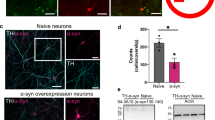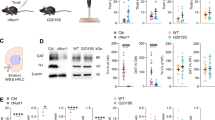Abstract
Why dopamine-containing neurons of the brain’s substantia nigra pars compacta die in Parkinson’s disease has been an enduring mystery. Our studies suggest that the unusual reliance of these neurons on L-type Cav1.3 Ca2+ channels to drive their maintained, rhythmic pacemaking renders them vulnerable to stressors thought to contribute to disease progression. The reliance on these channels increases with age, as juvenile dopamine-containing neurons in the substantia nigra pars compacta use pacemaking mechanisms common to neurons not affected in Parkinson’s disease. These mechanisms remain latent in adulthood, and blocking Cav1.3 Ca2+ channels in adult neurons induces a reversion to the juvenile form of pacemaking. Such blocking (‘rejuvenation’) protects these neurons in both in vitro and in vivo models of Parkinson’s disease, pointing to a new strategy that could slow or stop the progression of the disease.
This is a preview of subscription content, access via your institution
Access options
Subscribe to this journal
Receive 51 print issues and online access
$199.00 per year
only $3.90 per issue
Buy this article
- Purchase on SpringerLink
- Instant access to full article PDF
Prices may be subject to local taxes which are calculated during checkout





Similar content being viewed by others
References
Braak, H., Ghebremedhin, E., Rub, U., Bratzke, H. & Del Tredici, K. Stages in the development of Parkinson’s disease-related pathology. Cell Tissue Res. 318, 121–134 (2004)
Hornykiewicz, O. Dopamine (3-hydroxytyramine) and brain function. Pharmacol. Rev. 18, 925–964 (1966)
Riederer, P. & Wuketich, S. Time course of nigrostriatal degeneration in Parkinson’s disease. A detailed study of influential factors in human brain amine analysis. J. Neural Transm. 38, 277–301 (1976)
Abou-Sleiman, P. M., Muqit, M. M. & Wood, N. W. Expanding insights of mitochondrial dysfunction in Parkinson’s disease. Nature Rev. Neurosci. 7, 207–219 (2006)
Zhang, L. et al. Mitochondrial localization of the Parkinson’s disease related protein DJ-1: Implications for pathogenesis. Hum. Mol. Genet. 14, 2063–2073 (2005)
Kwong, J. Q., Beal, M. F. & Manfredi, G. The role of mitochondria in inherited neurodegenerative diseases. J. Neurochem. 97, 1659–1675 (2006)
Bender, A. et al. High levels of mitochondrial DNA deletions in substantia nigraneurons in aging and Parkinson disease. Nature Genet. 38, 515–517 (2006)
Kraytsberg, Y. et al. Mitochondrial DNA deletions are abundant and cause functional impairment in aged human substantia nigra neurons. Nature Genet. 38, 518–520 (2006)
Swerdlow, R. H. et al. Origin and functional consequences of the complex I defect in Parkinson’s disease. Ann. Neurol. 40, 663–671 (1996)
Dawson, T. M. & Dawson, V. L. Molecular pathways of neurodegeneration in Parkinson’s disease. Science 302, 819–822 (2003)
Greenamyre, J. T. & Hastings, T. G. Biomedicine. Parkinson’s—divergent causes, convergent mechanisms. Science 304, 1120–1122 (2004)
Zecca, L., Zucca, F. A., Wilms, H. & Sulzer, D. Neuromelanin of the substantia nigra: A neuronal black hole with protective and toxic characteristics. Trends Neurosci. 26, 578–580 (2003)
Michel, P. P. & Hefti, F. Toxicity of 6-hydroxydopamine and dopamine for dopaminergic neurons in culture. J. Neurosci. Res. 26, 428–435 (1990)
Kish, S. J., Shannak, K. & Hornykiewicz, O. Uneven pattern of dopamine loss in the striatum of patients with idiopathic Parkinson’s disease. Pathophysiologic and clinical implications. N. Engl. J. Med. 318, 876–880 (1988)
Hasbani, D. M., Perez, F. A., Palmiter, R. D. & O’Malley, K. L. Dopamine depletion does not protect against acute 1-methyl-4-phenyl-1,2,3,6-tetrahydropyridine toxicity in vivo. J. Neurosci. 25, 9428–9433 (2005)
Fahn, S. Does levodopa slow or hasten the rate of progression of Parkinson’s disease? J. Neurol. 252 (Suppl. 4). IV37–IV42 (2005)
Mercuri, N. B. et al. Effects of dihydropyridine calcium antagonists on rat midbrain dopaminergic neurones. Br. J. Pharmacol. 113, 831–838 (1994)
Nedergaard, S., Flatman, J. A. & Engberg, I. Nifedipine- and omega-conotoxin-sensitive Ca2+ conductances in guinea-pig substantia nigra pars compacta neurones. J. Physiol. (Lond.) 466, 727–747 (1993)
Shepard, P. D. & Stump, D. Nifedipine blocks apamin-induced bursting activity in nigral dopamine-containing neurons. Brain Res. 817, 104–109 (1999)
Xu, W. & Lipscombe, D. Neuronal CaV1.3α1 L-type channels activate at relatively hyperpolarized membrane potentials and are incompletely inhibited by dihydropyridines. J. Neurosci. 21, 5944–5951 (2001)
Olson, P. A. et al. G-protein-coupled receptor modulation of striatal CaV1.3 L-type Ca2+ channels is dependent on a Shank-binding domain. J. Neurosci. 25, 1050–1062 (2005)
Koschak, A. et al. α1D (Cav1.3) subunits can form L-type Ca2+ channels activating at negative voltages. J. Biol. Chem. 276, 22100–22106 (2001)
Scholze, A., Plant, T. D., Dolphin, A. C. & Nurnberg, B. Functional expression and characterization of a voltage-gated CaV1.3 (α1D) calcium channel subunit from an insulin-secreting cell line. Mol. Endocrinol. 15, 1211–1221 (2001)
Surmeier, D. J., Mercer, J. N. & Chan, C. S. Autonomous pacemakers in the basal ganglia: Who needs excitatory synapses anyway? Curr. Opin. Neurobiol. 15, 312–318 (2005)
Zolles, G. et al. Pacemaking by HCN channels requires interaction with phosphoinositides. Neuron 52, 1027–1036 (2006)
Neuhoff, H., Neu, A., Liss, B. & Roeper, J. Ih channels contribute to the different functional properties of identified dopaminergic subpopulations in the midbrain. J. Neurosci. 22, 1290–1302 (2002)
Beal, M. F. Excitotoxicity and nitric oxide in Parkinson’s disease pathogenesis. Ann. Neurol. 44, S110–S114 (1998)
Coyle, J. T. & Puttfarcken, P. Oxidative stress, glutamate, and neurodegenerative disorders. Science 262, 689–695 (1993)
Krieger, C. & Duchen, M. R. Mitochondria, Ca2+ and neurodegenerative disease. Eur. J. Pharmacol. 447, 177–188 (2002)
Verkhratsky, A. Physiology and pathophysiology of the calcium store in the endoplasmic reticulum of neurons. Physiol. Rev. 85, 201–279 (2005)
Dauer, W. & Przedborski, S. Parkinson’s disease: mechanisms and models. Neuron 39, 889–909 (2003)
Phinney, A. L. et al. Enhanced sensitivity of dopaminergic neurons to rotenone-induced toxicity with aging. Parkinsonism Relat. Disord. 12, 228–238 (2006)
Betarbet, R. et al. Chronic systemic pesticide exposure reproduces features of Parkinson’s disease. Nature Neurosci. 3, 1301–1306 (2000)
Jiang, Q., Yan, Z. & Feng, J. Activation of group III metabotropic glutamate receptors attenuates rotenone toxicity on dopaminergic neurons through a microtubule-dependent mechanism. J. Neurosci. 26, 4318–4328 (2006)
Bywood, P. T. & Johnson, S. M. Mitochondrial complex inhibitors preferentially damage substantia nigra dopamine neurons in rat brain slices. Exp. Neurol. 179, 47–59 (2003)
Przedborski, S. & Vila, M. The 1-methyl-4-phenyl-1,2,3,6-tetrahydropyridine mouse model: A tool to explore the pathogenesis of Parkinson’s disease. Ann. NY Acad. Sci. 991, 189–198 (2003)
Petroske, E., Meredith, G. E., Callen, S., Totterdell, S. & Lau, Y. S. Mouse model of Parkinsonism: A comparison between subacute MPTP and chronic MPTP/probenecid treatment. Neuroscience 106, 589–601 (2001)
Wilson, C. J. & Callaway, J. C. Coupled oscillator model of the dopaminergic neuron of the substantia nigra. J. Neurophysiol. 83, 3084–3100 (2000)
Orrenius, S., Zhivotovsky, B. & Nicotera, P. Regulation of cell death: The calcium-apoptosis link. Nature Rev. Mol. Cell Biol. 4, 552–565 (2003)
Kazuno, A. A. et al. Identification of mitochondrial DNA polymorphisms that alter mitochondrial matrix pH and intracellular calcium dynamics. PLoS Genet. 2, e128 (2006)
Yamada, T., McGeer, P. L., Baimbridge, K. G. & McGeer, E. G. Relative sparing in Parkinson’s disease of substantia nigra dopamine neurons containing calbindin-D28K. Brain Res. 526, 303–307 (1990)
Ai, Y. et al. Intraputamenal infusion of GDNF in aged rhesus monkeys: Distribution and dopaminergic effects. J. Comp. Neurol. 461, 250–261 (2003)
Coleman, M. Axon degeneration mechanisms: Commonality amid diversity. Nature Rev. Neurosci. 6, 889–898 (2005)
Kupsch, A. et al. Pretreatment with nimodipine prevents MPTP-induced neurotoxicity at the nigral, but not at the striatal level in mice. Neuroreport 6, 621–625 (1995)
Kupsch, A. et al. 1-Methyl-4-phenyl-1,2,3,6-tetrahydropyridine-induced neurotoxicity in non-human primates is antagonized by pretreatment with nimodipine at the nigral, but not at the striatal level. Brain Res. 741, 185–196 (1996)
Grossman, E., Messerli, F. H., Oren, S., Nunez, B. & Garavaglia, G. E. Cardiovascular effects of isradipine in essential hypertension. Am. J. Cardiol. 68, 65–70 (1991)
Johnson, B. A., Devous, M. D., Ruiz, P. & Ait-Daoud, N. Treatment advances for cocaine-induced ischemic stroke: Focus on dihydropyridine-class calcium channel antagonists. Am. J. Psychiatry 158, 1191–1198 (2001)
Rodnitzky, R. L. Can calcium antagonists provide a neuroprotective effect in Parkinson’s disease? Drugs 57, 845–849 (1999)
Chan, C. S., Shigemoto, R., Mercer, J. N. & Surmeier, D. J. HCN2 and HCN1 channels govern the regularity of autonomous pacemaking and synaptic resetting in globus pallidus neurons. J. Neurosci. 24, 9921–9932 (2004)
Hows, M. E. et al. High-performance liquid chromatography/tandem mass spectrometry assay for the determination of 1-methyl-4-phenyl pyridinium (MPP+) in brain tissue homogenates. J. Neurosci. Methods 137, 221–226 (2004)
Platzer, J. et al. Congenital deafness and sinoatrial node dysfunction in mice lacking class D L-type Ca2+ channels. Cell 102, 89–97 (2000)
Nelson, E. L., Liang, C. L., Sinton, C. M. & German, D. C. Midbrain dopaminergic neurons in the mouse: Computer-assisted mapping. J. Comp. Neurol. 369, 361–371 (1996)
Paxinos, G. & Franklin, K. B. J. The Mouse Brain in Stereotaxic Coordinates (Elsevier Academic, San Diego, 2004)
Grace, A. A. & Bunney, B. S. The control of firing pattern in nigral dopamine neurons: Single spike firing. J. Neurosci. 4, 2866–2876 (1984)
Grace, A. A. & Onn, S. P. Morphology and electrophysiological properties of immunocytochemically identified rat dopamine neurons recorded in vitro. J. Neurosci. 9, 3463–3481 (1989)
Yung, W. H., Hausser, M. A. & Jack, J. J. Electrophysiology of dopaminergic and non-dopaminergic neurones of the guinea-pig substantia nigra pars compacta in vitro. J. Physiol. (Lond.) 436, 643–667 (1991)
Maurice, N. et al. D2 dopamine receptor-mediated modulation of voltage-dependent Na+ channels reduces autonomous activity in striatal cholinergic interneurons. J. Neurosci. 24, 10289–10301 (2004)
Tkatch, T., Baranauskas, G. & Surmeier, D. J. Basal forebrain neurons adjacent to the globus pallidus co-express GABAergic and cholinergic marker mRNAs. Neuroreport 9, 1935–1939 (1998)
Song, W. J. et al. Somatodendritic depolarization-activated potassium currents in rat neostriatal cholinergic interneurons are predominantly of the A type and attributable to coexpression of Kv4.2 and Kv4.1 subunits. J. Neurosci. 18, 3124–3137 (1998)
Surmeier, D. J., Song, W. J. & Yan, Z. Coordinated expression of dopamine receptors in neostriatal medium spiny neurons. J. Neurosci. 16, 6579–6591 (1996)
Mandir, A. S. et al. Poly(ADP-ribose) polymerase activation mediates 1-methyl-4-phenyl-1, 2,3,6-tetrahydropyridine (MPTP)-induced parkinsonism. Proc. Natl Acad. Sci. USA 96, 5774–5779 (1999)
Meredith, G. E. & Kang, U. J. Behavioral models of Parkinson’s disease in rodents: A new look at an old problem. Mov. Disord. 21, 1595–1606 (2006)
Hines, M. L. & Carnevale, N. T. NEURON: A tool for neuroscientists. Neuroscientist 7, 123–135 (2001)
Migliore, M., Cook, E. P., Jaffe, D. B., Turner, D. A. & Johnston, D. Computer simulations of morphologically reconstructed CA3 hippocampal neurons. J. Neurophysiol. 73, 1157–1168 (1995)
Wang, J., Chen, S., Nolan, M. F. & Siegelbaum, S. A. Activity-dependent regulation of HCN pacemaker channels by cyclic AMP: Signaling through dynamic allosteric coupling. Neuron 36, 451–461 (2002)
Shen, W., Hamilton, S. E., Nathanson, N. M. & Surmeier, D. J. Cholinergic suppression of KCNQ channel currents enhances excitability of striatal medium spiny neurons. J. Neurosci. 25, 7449–7458 (2005)
Acknowledgements
This work was supported by grants from the Picower Foundation and NIH NINDS to D.J.S. and G.E.M. We thank J. Held, D. Wokosin, P. Hockberger, E. Mugnaini, S. Ulrich, K. Saporito, Q. Ruan, J. Jackolin, F. Jodelka and M. Avram for help with this work.
Author information
Authors and Affiliations
Corresponding author
Ethics declarations
Competing interests
Reprints and permissions information is available at www.nature.com/reprints. The authors declare no competing financial interests.
Supplementary information
Supplementary Information
This file contains Supplementary Figures S1-S7 with Legends. (PDF 4256 kb)
Rights and permissions
About this article
Cite this article
Chan, C., Guzman, J., Ilijic, E. et al. ‘Rejuvenation’ protects neurons in mouse models of Parkinson’s disease. Nature 447, 1081–1086 (2007). https://doi.org/10.1038/nature05865
Received:
Accepted:
Published:
Issue Date:
DOI: https://doi.org/10.1038/nature05865
This article is cited by
-
Mitochondrial dysfunction in Parkinson’s disease – a key disease hallmark with therapeutic potential
Molecular Neurodegeneration (2023)
-
The alpha-synuclein oligomers activate nuclear factor of activated T-cell (NFAT) modulating synaptic homeostasis and apoptosis
Molecular Medicine (2023)
-
Aberrant somatic calcium channel function in cNurr1 and LRRK2-G2019S mice
npj Parkinson's Disease (2023)
-
Longitudinal associations between use of antihypertensive, antidiabetic, and lipid-lowering medications and biological aging
GeroScience (2023)
-
Extended spectrum of Cav1.3 channelopathies
Pflügers Archiv - European Journal of Physiology (2023)




